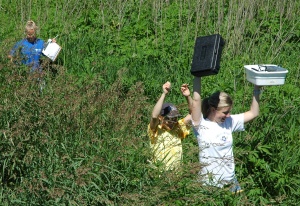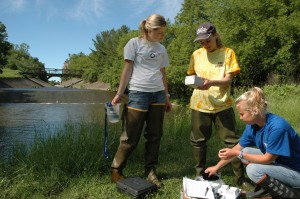Luther College water quality research team collects and tests samples of water at a stream that flows through The Cut on the west edge of Decorah. Working in cooperation with Iowa State University Extension, and the Iowa Department of Natural resources, the Luther team are (left to right) Chelsea Weiss of Eldridge, Iowa, a sophomore majoring in biology and political science, Jodi Enos-Berlage, Ph.D., Luther professor of biology, and Sharon Heyer of Cedar Rapids, Iowa, a senior majoring in biology and Spanish.
DECORAH, Iowa – On an early June day, Jodi Enos-Berlage, Ph.D., Luther College professor of biology, and two Luther students are hiking waist-high in weeds looking for old paths giving access to Dry Run Creek near Decorah.
The three are checking on the health of Dry Run and Twin Springs creeks, dropping probes in the water and taking water samples.
Sharon Heyer of Cedar Rapids, Iowa, a senior biology and Spanish major, and Chelsea Weiss of Eldridge, Iowa, a sophomore biology and political science major, are with Professor Enos-Berlage today. Both have made one previous trip to the watershed.
 Rain the day before provided the reason to be outdoors – the increased water flow may yield significant data. But the recent, frequent rains also present a minor but annoying problem.
Rain the day before provided the reason to be outdoors – the increased water flow may yield significant data. But the recent, frequent rains also present a minor but annoying problem.
Nearly all sampling sites – there are 10 in all – are a short hike from the roads but paths to the sites are already overgrown with weeds, including some plants the samplers would like to avoid. For consistency, they want to take samples at the same location each trip, but access and appearance of some sites has changed in a short time.
Today they find the streams are running higher than normal but not muddier. Many parameters don’t appear too far from norms. They get immediate numbers on turbidity (amount of sediment suspended in the water), pH (acidity or base level), temperature, dissolved oxygen, conductivity and chloride level.
 This is the fourth time this spring the Luther crew is making the circuit of sampling sites. The schedule calls for once-a-month trips but they also go out following a rain event producing at least one-half inch – if it happens during the first half of the week.
This is the fourth time this spring the Luther crew is making the circuit of sampling sites. The schedule calls for once-a-month trips but they also go out following a rain event producing at least one-half inch – if it happens during the first half of the week.
The Dry Run Creek sampling/testing program represents a partnership between Luther College, Iowa State Extension, and the Iowa Department of Natural Resources to establish some baseline data for the recently formed Dry Run Creek Watershed Improvement Association, Inc., a group of watershed landowners.
In time, the results should help watershed producers establish a set of management practices to improve water quality.
Water quality testing is a new effort in Dry Run watershed, but not for Luther College. Professor Enos-Berlage’s biology faculty predecessors John Tjostem and Jim Eckblad, both now retired, were involved in water quality testing, including numerous streams and many northeast Iowa wells.
Current Dry Run watershed efforts began last year with some initial contacts through letters among landowners seeking ways they could cooperate on water quality practices in the watershed. Dry Run Creek is currently classified as impaired by the IDNR’s 308(d) report – the specific impairment is high bacteria levels. In January of this year the producers group decided to initiate water monitoring – Enos-Berlage and her family coincidentally own and operate a small farm in the watershed.
About the same time Ben Kuennen, watershed specialist with Iowa State University Extension’s watershed projects office in Fayette, contacted the head of the biology department at Luther seeking cooperation in a water-monitoring program for the watershed. That contact was passed on to Enos-Berlage, as the microbiologist in the department.
“I became interested for multiple reasons,” Enos-Berlage says, beyond living in the watershed and getting the letter. She grew up on a 350-acre cow-calf farm in Illinois and her husband has a dairy background. Her interests in agriculture, science, and the environment are reflected in the goals of this watershed improvement project.
The project is also attractive to Enos-Berlage as a science educator (she’s in her 10th year as a faculty member in the Luther biology department). “The project aligns well with Luther’s sustainability mission,” she said. “Luther has taken a lead role in sustainability initiatives among educational institutions, and participating in a local project aimed at preserving and protecting a natural resource definitely falls within this realm.”
Luther continues to develop various environmental and sustainability programs, and environmental topics are common in the classroom–thus a sampling program in Dry Run would offer opportunities for the school.
Enos-Berlage plans to incorporate the Dry Run Creek Watershed monitoring into her fall microbiology course. In fact, she is designing a new laboratory exercise for her 100-student course that will include a field trip to at least one Dry Run monitoring site, followed by sampling and analysis back in the laboratory.
Students aren’t expected to remain on campus during summer, Enos-Berlage explains, but Luther is providing funding for Chelsea and Sharon to do the water sampling as directed research. In addition, they spend time working on research with an evolutionary biologist and maintaining biology department equipment. Both students made visits to a Dry Run landowners meeting in mid-June to discuss their monitoring work and early results. Later this summer, Chelsea and Sharon will also begin work with an entomologist to analyze the benthic (bottom-dwelling) invertebrates in select locations of Dry Run Creek, as these organisms can also be useful indicators of stream health.
Luther students, Lisa Hieb, a senior biology major from Brookings, S.D., and Jacob Seibert, a junior biology major from Rockford, Iowa, were involved earlier in the spring with the water monitoring project and will continue when they return to campus in the fall.
Students working on the project during the semester will receive class credit for the sampling, and Enos-Berlage explains other benefits. The monitoring program “is very data rich,” she says, “(and it) provides tangible undergraduate research projects with real-world applications.” There is no individual “ownership” of the information, so any student working on the project can perform analysis of the data, perhaps applying the research towards their required senior project.
Dry Run’s monitoring program examines 10 different parameters, but five samples – E. coli bacteria, ammonia, nitrite and nitrate, total nitrogen, and total phosphorus – must be sent to the University Hygienic Lab in Iowa City for testing, so they collect vials of water.
Mailing water samples to UHL has limitations – sampling must be done in the first half of the week to allow time for the samples to reach the lab in time for testing, which precludes watershed trips Thursday to Sunday.
Enos-Berlage and Lynette Seigley, a research geologist with the IDNR’s water monitoring and assessment section, are working on establishing protocols for the sampling that would let the college do all the work in house.
“We have that interest for a couple of reasons,” Enos-Berlage says, including “we want to be involved in the laboratory analysis and have our students experience this aspect of the work.” In addition, doing the lab analysis at Luther would allow more timing flexibility for the rain event sampling and would likely save on costs.
The monitoring trips usually begin near where Dry Run Creek joins the Upper Iowa. The creek flows underneath Highway 52, confined to a concrete spillway through an area known as “the cut.” Dry Run and Twin Springs creeks join within a city campground before they flow into the Upper Iowa River, making it easy to sample both with one stop. It’s a pleasant morning, there are many campers in the park and there’s just a short walk between the two sites.
Dry Run Creek watershed is a wedge of land totaling more than 20,000 acres between Iowa Highway 9 and U.S. 52. Twin Springs Creek runs east to west just north of Highway 9. Both watersheds are hilly and after the stop at the campground, the water sample trio heads out Highway 9 for the first rural site.
Both streams drain farmland along Highways 9 and 52, a mix of fields used for cropland and livestock. The mix of water use, recreation and agriculture, is not unusual in the Midwest. Dry Run Creek flows through a central outdoor recreational area in Decorah, specifically an intersection point of two major parks, two campgrounds, and hiking and biking trails, highlighting the concerns of those living in or near to the watershed or using the stream for recreation.
All sites were selected by Lynette Seigley and ISUE water projects staff to reflect the watersheds and provide appropriate results. Initially, they marked 20 sites but that number was pared to 10 high priority sites. A few sites are on tributaries of both creeks and Enos-Berlage explains they might add other sites if data present results that call for additional testing.
Enos-Berlage is enthusiastic about what the data can provide: “The big picture is that I think the data will help producers decide where to make land improvements (to get the most benefit) and support grant proposals to obtain the funds to do it.”


Leave a comment